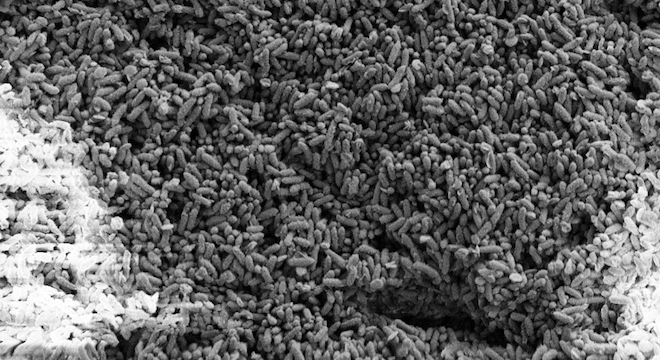TINA CASEY
Scientists at the U.S. Naval Research Laboratory are developing a small robotic planetary exploration vehicle that weighs about two pounds, powered by the unique electricity-generating properties of a mud-dwelling microorganism called Geobacter.
The Geobacter would be used in a fuel cell powerful enough to run the microrover’s basic functions while also charging a small battery. The battery would kick into use as needed to run additional equipment and to operate the microrover’s propulsion system.
The microrover could explore environments hostile to humans and impractical for bulky equipment, where refueling or battery replacement would be difficult if not impossible. In addition to land or sea exploration, the microrover could be used in space.
“The goal is to demonstrate a more efficient and reliable energy source for use in powering small robotic vehicles in environments where the option for human intervention is non-existent,” said the project leader, space robotics scientist Dr. Gregory P. Scott, in a statement. “Microbial fuel cells coupled with extremely low-power electronics and a low energy requirement for mobility addresses gaps in power technology applicable to all robotic systems, especially planetary robotics.”
The Office of Naval Research has been exploring the use of microbes in fuel cells for a number of years, primarily for sensing equipment used to monitor ocean environments. In 2010, the Navy showcased a group of microbial fuel cell projects at a Pentagon Earth Day event including one that tracks the location of sea turtles feeding near seaports, in order to avoid collisions with ships or construction projects.
As research chemist Dr. Leonard Tender of the Naval Research Laboratory explained in a press statement for that earlier event:
“We work on the intersection of microbiology and electrochemistry,” Tender said. “The most fascinating aspect of the program is how these micro-organisms function and the mechanisms by which they take fuel, metabolize it and generate electrical current.”
Meanwhile, the new planetary rover is being designed to run on the Geobacter species discovered in 1987, when Dr. Derek Lovely of the University of Massachusetts at Amherst found it dwelling in the mud in the Potomac River near Washington D.C. It is a type of bacteria that thrives in anaerobic (oxygen-free) environments — perfect for space travel and other environments hostile to human life.
Anaerobic bacteria are commonly used in wastewater treatment to break down organic material rapidly and efficiently. As they digest the nutrients in wastewater, the bacteria produce energy in the form of methane gas, so their application to other forms of energy production is a natural next step.
Geobacters are of particular interest because they can transfer electrons outside of the cell and move them over relatively long distances through filaments called microbial nanowires. In other words, they can generate electricity directly from common, inexpensive feedstocks, including vinegar. The microrover project is focused on a Geobacter called G. sulfurreducens.
Because of their energy density, Geobacters have the potential to enable the production of a fuel cell with less mass but greater efficiency than the next best thing, a lithium-ion battery.
However, the microrover concept is still in the initial research stages and the team will have to overcome some foundational obstacles inherent in current microbial fuel cell technology, which relies on bulky pumping systems.
As for the Navy’s interest in space travel, that derives from its entwined mission with the U.S. Air Force, overarched by the relationship between NASA and the U.S. military. As a precursor to space travel, the Office of Naval Research broke a record for a manned, high-altitude balloon flight in the 1950’s.
The microrover project was funded through a research grant from the NASA Innovative Advanced Concepts program, which is an incubator for “high risk-high payoff ideas” similar to DARPA, the military research agency that engendered the Internet among other things. NIAC was initiated during the Clinton Administration as the NASA Institute for Advanced Concepts. That program was shelved toward the end of the Bush administration but was revived in its current form under President Obama.









